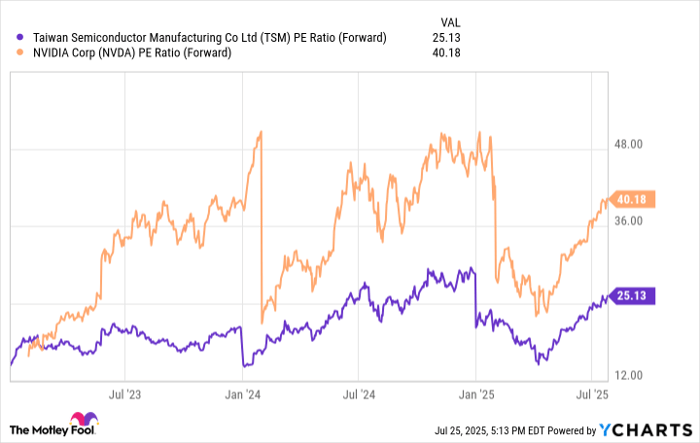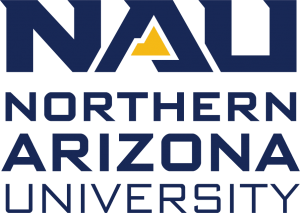AI Research
This Artificial Intelligence (AI) Stock Will Outperform Nvidia by 2030

Key Points
-
Nvidia can credit the rise in its stock to relentless demand for its chipsets over the last few years.
-
Rising spending on servers, networking equipment, and data centers suggests that infrastructure could be the next big theme in the AI story.
-
While rising infrastructure spending bodes well for Nvidia, foundry specialist Taiwan Semiconductor Manufacturing may be even better positioned.
-
10 stocks we like better than Taiwan Semiconductor Manufacturing ›
When ChatGPT was released to the broader public on Nov. 30, 2022, Nvidia had a market capitalization of just $345 billion. As of the closing bell on July 25, 2025, its market cap had eclipsed $4.2 trillion, making it the most valuable company in the world — by a pretty wide margin, too.
Given these historic gains, it’s not entirely surprising that for many growth investors, the artificial intelligence (AI) movement revolves around Nvidia. At this point, the company is basically seen as a barometer measuring the overall health of the entire AI sector.
Where to invest $1,000 right now? Our analyst team just revealed what they believe are the 10 best stocks to buy right now. Learn More »
It’s hard to bet against Nvidia, but I do see another stock in the semiconductor realm that appears better positioned for long-terms gains.
Let’s explore what makes Taiwan Semiconductor Manufacturing (NYSE: TSM) such a compelling opportunity in the chip space right now, and the catalysts at play that could fuel returns superior to Nvidia’s over the next several years.
The AI infrastructure wave is just starting
I like to think of the AI narrative as a story. For the last few years, the biggest chapter revolved around advanced chipsets called graphics processing units (GPUs), which are used across a variety of generative AI applications. These include building large language models (LLMs), machine learning, robotics, self-driving cars, and more.
These various applications are only now beginning to come into focus. The next big chapter in the AI storyline is how infrastructure is going to play a role in actually developing and scaling up these more advanced technologies.
Global management consulting firm McKinsey & Company estimates that investments in AI infrastructure could reach $6.7 trillion over the next five years, with a good portion of that allocated toward hardware for data centers.
Piggybacking off of this idea, consider that cloud hyperscalers Amazon, Microsoft, and Alphabet, along with their “Magnificent Seven” peer Meta Platforms, are expected to devote north of $330 billion on capital expenditures (capex) just this year. Much of this is going toward additional servers, chips, and networking equipment for accelerated AI data center expansion.
To me, the aggressive spending on capex from the world’s largest businesses is a strong signal that the infrastructure wave in AI is beginning to take shape.
Image Source: Getty Images.
This is great for Nvidia and even better for TSMC
Rising AI infrastructure investment is a great tailwind for Nvidia but also a source of growth for Advanced Micro Devices, Broadcom, and many others.
Unlike AMD or Nvidia, though, growth for Taiwan Semiconductor (TSMC for short) doesn’t really hinge on the success of a particular product line. In other words, Nvidia and AMD are competing fiercely against one another to win AI workloads, which boils down to which of them can design the most powerful, energy efficient chips at an affordable price.
The investment case around TSMC is that it could be seen as more of an agnostic player in the AI chip market because its foundry and fabrication services stand to benefit from broader, more secular tailwinds fueling AI infrastructure — regardless of whose chips create the most demand.
Think of TSMC as the company actually making the picks and shovels that Nvidia, AMD, and other chip companies need to go out and sell while competing among one another.
TSMC’s “Nvidia moment” may be here
The valuation disparity between Nvidia and TSMC says a couple of things about how the latter is viewed in the broader chip landscape.

TSM PE Ratio (Forward) data by YCharts; PE = price to earnings.
Companies such as Nvidia and AMD rely heavily on TSMC’s foundry and fabrication services, which are essentially the backbone of the chip industry. While some on Wall Street would argue that Nvidia has a technological moat thanks to its one-two punch of chips and software, I think that TSMC has an underappreciated moat that provides the company with broader exposure to the chip industry compared to its peers.
Over the next five years, I think use cases of AI development increase as businesses seek to expand beyond their current markets in cloud computing, cybersecurity, enterprise software, among others.
Emerging applications such as autonomous driving and quantum computing will drive demand for GPUs and data center capacity even further. For this reason, TSMC may be on the verge of an “Nvidia moment” featuring prolonged, explosive growth.
TSMC’s modest forward price-to-earnings multiple (P/E) of 25 puts it in a unique position compared to Nvidia (with its forward P/E of 40) for considerable expansion as the infrastructure chapter of AI continues to be written.
I think Taiwan Semiconductor Manufacturing’s valuation will increasingly become more congruent with the company’s growth over the next several years, and so I predict that the stock will outperform Nvidia by 2030.
Should you invest $1,000 in Taiwan Semiconductor Manufacturing right now?
Before you buy stock in Taiwan Semiconductor Manufacturing, consider this:
The Motley Fool Stock Advisor analyst team just identified what they believe are the 10 best stocks for investors to buy now… and Taiwan Semiconductor Manufacturing wasn’t one of them. The 10 stocks that made the cut could produce monster returns in the coming years.
Consider when Netflix made this list on December 17, 2004… if you invested $1,000 at the time of our recommendation, you’d have $630,291!* Or when Nvidia made this list on April 15, 2005… if you invested $1,000 at the time of our recommendation, you’d have $1,075,791!*
Now, it’s worth noting Stock Advisor’s total average return is 1,039% — a market-crushing outperformance compared to 182% for the S&P 500. Don’t miss out on the latest top 10 list, available when you join Stock Advisor.
See the 10 stocks »
*Stock Advisor returns as of July 29, 2025
Adam Spatacco has positions in Alphabet, Amazon, Meta Platforms, Microsoft, and Nvidia. The Motley Fool has positions in and recommends Advanced Micro Devices, Alphabet, Amazon, Meta Platforms, Microsoft, Nvidia, and Taiwan Semiconductor Manufacturing. The Motley Fool recommends Broadcom and recommends the following options: long January 2026 $395 calls on Microsoft and short January 2026 $405 calls on Microsoft. The Motley Fool has a disclosure policy.
Disclaimer: For information purposes only. Past performance is not indicative of future results.
AI Research
AUI, PMU Sign Agreement to Establish AI Research Chair in Morocco

Rabat — Al Akhawayn University in Ifrane (AUI) and Prince Mohammed Bin Fahd University (PMU) announced an agreement establishing the Prince Mohammed Bin Fahd bin Abdulaziz Chair for Artificial Intelligence Applications.
A statement from AUI said Amine Bensaid, President of AUI, signed the agreement with his PMU counterpart Issa Al Ansari.
The Chair, established within AUI, will conduct applied research in AI to develop solutions that address societal needs and promote innovation to support Moroccan talents in their fields.
The agreement reflects a shared commitment to strengthen cooperation between the two institutions, with a focus on AI to contribute to the socio-economic development of both Morocco and Saudi Arabia, the statement added.
The initiative also seeks to help Morocco and Saudi Arabia boost their national priorities through AI as a key tool in advancing academic excellence.
Bensaid commented on the agreement, saying that the partnership will strengthen Al Akhawayn’s mission to “combine academic excellence with technological innovation.”
It will also help to master students’ skills in AI in order to serve humanity and protect citizens from risk.
“By hosting this initiative, we also affirm the role of Al Akhawayn and Morocco as pioneering actors in this field in Africa and in the region.”
For his part, Al Ansari also expressed satisfaction with the new agreement, stating that the pact is in line with PU’s efforts to serve Saudi Arabia’s Vision 2030.
This vision “places artificial intelligence at the heart of economic and social transformation,” he affirmed.
He also expressed his university’s commitment to working with Al Akhawayn University to help address tomorrow’s challenges and train the new generation of talents that are capable of shaping the future.
Al Akhawayn has been reiterating its commitment to continue to cooperate with other institutions in order to boost research as well as ethical AI use.
In April, AUI signed an agreement with the American University of Sharjah to promote collaboration in research and teaching, as well as to empower Moroccan and Emirati students and citizens to engage with AI tools while staying rooted in their cultural identity.
This is in line with Morocco’s ambition to enhance AI use in its own education sector.
In January, Secretary General of Education Younes Shimi outlined Morocco’s ambition and advocacy for integrating AI into education.
He also called for making this technology effective, adaptable, and accessible for the specific needs of Moroccans and for the rest of the Arab world.
AI Research
How NAU professors are using AI in their research – The NAU Review

Generative AI is in classrooms already. Can educators use this tool to enhance learning among their students instead of undercutting assignments?
Yes, said Priyanka Parekh, an assistant research professor in the Center for STEM Teaching and Learning at NAU. With a grant from NAU’s Transformation through Artificial Intelligence in Learning (TRAIL) program, Parekh is investigating how undergraduate students use GenAI as learning partners—building on what they learn in the classroom to maximize their understanding of STEM topics. It’s an important question as students make increasing use of these tools with or without their professors’ knowledge.
“As GenAI becomes an integral part of everyday life, this project contributes to building critical AI literacy skills that enable individuals to question, critique and ethically utilize AI tools in and beyond the school setting,” Parekh said.
That is the foundation of the TRAIL program, which is in its second year of offering grants to professors to explore how to use GenAI in their work. Fourteen professors received grants to implement GenAI in their classrooms this year. Now in its second year, the Office of the Provost partnered with the Office of the Vice President for Research to offer grants to professors in five different colleges to study the use of GenAI tools in research.
The recipients are:
- Chris Johnson, School of Communication, Integrating AI-Enhanced Creative Workflows into Art, Design, Visual Communication, and Animation Education
- Priyanka Parekh, Center for Science Teaching and Learning, Understanding Learner Interactions with Generative AI as Distributed Cognition
- Marco Gerosa, School of Informatics, Computing, and Cyber Systems, To what extent can AI replace human subjects in software engineering research?
- Emily Schneider, Criminology and Criminal Justice, Israeli-Palestinian Peacebuilding through Artificial Intelligence
- Delaney La Rosa, College of Nursing, Enhancing Research Proficiency in Higher Education: Analyzing the Impact of Afforai on Student Literature Review and Information Synthesis
Exploring how GenAI shapes students as learners
Parekh’s goals in her research are to understand how students engage with GenAI in real academic tasks and what this learning process looks like; to advance AI literacy, particularly among first-generation, rural and underrepresented learners; help faculty become more comfortable with AI; and provide evidence-based recommendations for integrating GenAI equitably in STEM education.
It’s a big ask, but she’s excited to see how the study shakes out and how students interact with the tools in an educational improvement. She anticipates her study will have broader applications as well; employees in industries like healthcare, engineering and finance are using AI, and her work may help implement more equitable GenAI use across a variety of industries.
“Understanding how learners interact with GenAI to solve problems, revise ideas or evaluate information can inform AI-enhanced workplace training, job simulations and continuing education,” she said.
Using AI as a collaborator, not a shortcut
Johnson, a professor of visual communication in the School of Communication, isn’t looking for AI to create art, but he thinks it can be an important tool in the creation process—one that helps human creators create even better art. His project will include:
- Building a set of classroom-ready workflows that combine different industry tools like After Effects, Procreate Dreams and Blender with AI assistants for tasks such as storyboarding, ideation, cleanup, accessibility support
- Running guided stories to compare baseline pipelines to AI-assisted pipelines, looking at time saved and quality
- Creating open teaching modules that other instructors can adopt
In addition to creating usable, adaptable curriculum that teaches students to use AI to enhance their workflow—without replacing their work—and to improve accessibility standards, Johnson said this study will produce clear before and after case studies that show where AI can help and where it can’t.
“AI is changing creative industries, but the real skill isn’t pressing a button—it’s knowing how to direct, critique and refine AI as a collaborator,” Johnson said. “That’s what we’re teaching our students: how to keep authorship, ethics and creativity at the center.”
Johnson’s work also will take on the ethics of training and provenance that are a constant part of the conversation around using AI in art creation. His study will emphasize tools that respect artists’ rights and steer clear of imitating the styles of living artists without consent. He also will emphasize to students where AI fits into the work; it’s second in the process after they’ve initially created their work. It offers feedback; it doesn’t create the work.
Top photo: This is an image produced by ChatGPT illustrating Parekh’s research. I started with the prompt: “Can you make an image that has picture quality that shows a student with a reflection journal or interface showing their GenAI interaction and metacognitive responses (e.g., “Did this response help me?”)? It took a few rounds of changing the prompt, including telling AI twice to not put three hands into the image, to get to an image that reflects Parekh’s research and adheres to The NAU Review’s standards.
Heidi Toth | NAU Communications
(928) 523-8737 | heidi.toth@nau.edu
AI Research
Cruz unveils new AI framework as blueprint for future legislation

Ensuring American artificial intelligence tools become the global operating standard is the central mission of Texas Republican Sen. Ted Cruz’s new AI Legislative Framework, released on Wednesday alongside his long-awaited SANDBOX ACT.
The AI sandbox bill, which would create a federal AI testing setup within the White House’s Office of Science and Technology Policy, serves as part of the first pillar of Cruz’s new strategy that proposes a broad plan for Congressional legislative priorities surrounding AI.
The strategy is centered around five pillars: unleashing American innovation and long-term growth; protecting free speech in the AI age; preventing a patchwork of burdensome AI regulation; stopping nefarious use of AI against Americans; and defending human value and dignity.
“While this list is not exhaustive, it provides a starting point for discussion with both my colleagues and the administration on legislation that ensures the United States wins the AI race and benefits from this transformative technology,” Cruz said during a Wednesday Senate Commerce hearing.
Within each of these pillars, the strategy also lays out specific action items, such as creating the federal AI regulatory sandbox, protecting Americans against digital scams and fraud, reinvigorating bioethical considerations in federal policy and clarifying federal standards to prevent burdensome state AI regulations. Together, these inform the light-touch AI regulation that Cruz and the Trump administration have supported across the federal policy landscape and seeks to keep industry partners at the center of major regulatory decisions.
Cruz’s SANDBOX Act aims to exemplify that approach, offering exemption waivers for participating AI softwares from existing rules and restrictions that could impede the work done in the sandbox.
Cruz noted that Congress would be tasked with collecting regular reports on how often these rules and restrictions were modified to better understand the future policy needs of American AI operators.
“The SANDBOX Act is the first step,” Cruz said in the press release. “It embraces our nation’s entrepreneurial spirit and gives AI developers the room to create while still mitigating any health or consumer risks. The AI framework and SANDBOX Act ensure AI is defined by American values of defending human dignity, protecting free speech, and encouraging innovation.”
-

 Business2 weeks ago
Business2 weeks agoThe Guardian view on Trump and the Fed: independence is no substitute for accountability | Editorial
-
Tools & Platforms4 weeks ago
Building Trust in Military AI Starts with Opening the Black Box – War on the Rocks
-

 Ethics & Policy1 month ago
Ethics & Policy1 month agoSDAIA Supports Saudi Arabia’s Leadership in Shaping Global AI Ethics, Policy, and Research – وكالة الأنباء السعودية
-

 Events & Conferences4 months ago
Events & Conferences4 months agoJourney to 1000 models: Scaling Instagram’s recommendation system
-

 Jobs & Careers2 months ago
Jobs & Careers2 months agoMumbai-based Perplexity Alternative Has 60k+ Users Without Funding
-

 Education2 months ago
Education2 months agoVEX Robotics launches AI-powered classroom robotics system
-

 Podcasts & Talks2 months ago
Podcasts & Talks2 months agoHappy 4th of July! 🎆 Made with Veo 3 in Gemini
-

 Education2 months ago
Education2 months agoMacron says UK and France have duty to tackle illegal migration ‘with humanity, solidarity and firmness’ – UK politics live | Politics
-

 Funding & Business2 months ago
Funding & Business2 months agoKayak and Expedia race to build AI travel agents that turn social posts into itineraries
-

 Podcasts & Talks2 months ago
Podcasts & Talks2 months agoOpenAI 🤝 @teamganassi

